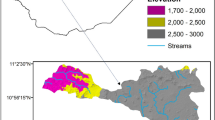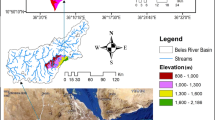Abstract
Bamboo forest is an important land use in the traditional village of Penglipuran, Bali Indonesia. Bamboo growing in the rural areas can be a good choice for capturing CO2. I harvested selected culms to determine biomass content, and 50 % of dry weight biomass was calculated as carbon content. The Penglipuran bamboo forest supported six bamboo species in a one hectare sampling plot, all of the genus Gigantochloa. The clump and culm densities were 339 and 7190 ha−1, respectively. Total above- plus below-ground biomass was 87.35 Mg ha−1, and carbon storage was 43.67 Mg ha−1. Carbon storage estimated in the bamboo forest at Penglipuran offers insight into the opportunity for PES (payment for ecosystem services) through emission trading mechanisms.
Similar content being viewed by others
References
Arinasa IBK, Peneng IN (2013) Jenis-jenis bambu di Bali dan potensinya. LIPI Press, Jakarta, p 118 (in Indonesian)
Arinasa IBK, Sujarwo W (2015) The diversity of endemic bamboo in Bali and conservation efforts. Bamboo J 29:85–92
Badan Pusat Statistik (2014) Bali dalam angka 2014. Badan Pusat Statistik Press, Denpasar, p 524 (in Indonesian)
Ben-zhi Z, Mao-yi F, Jin-zhong X, Xiao-sheng Y, Zheng-cai L (2005) Ecological functions of bamboo forest: research and application. J For Res 16(2):142–147
Brown S (1997) Estimating biomass and biomass change of tropical forests: a primer (FAO Forestry Paper 134). Food and Agriculture Organization of the United Nations, Rome, p 55
Bruce JP, Lee H, Haites EF (eds) (1996) Climate Change 1995: economic and social dimensions of climate change. Cambridge University Press, Cambridge, p 458
Chen X, Zhang X, Zhang Y, Booth T, He X (2009) Changes of carbon stocks in bamboo stands in China during 100 years. For Ecol Manag 258:1489–1496
Christanty L, Mailly D, Kimmins JP (1996) Without bamboo, the land dies: biomass, litter fall, and soil organic matter dynamics of a Javanese bamboo talun-kebun system. For Ecol Manag 87:75–88
Das DK, Chaturvedi OP (2006) Bambusa bambos (L.) Voss plantation in eastern India: I. Culm recruitment, dry matter dynamics and carbon flux. J Bamboo Rattan 5:47–59
Difan Z (1985) Bamboo development in China. In: Rao AN, Dhanaraja G, Sastry CB (eds), Research on Bamboo. In: Proceedings of the international bamboo workshop, Hangzhou, pp 20–22
Dransfield S, Widjaja EA (eds) (1995) Plant resources of South-East Asia 7: bamboos. Backhuys Publishers, Leiden, p 190
Embaye K, Weih M, Ledin S, Christersson L (2005) Biomass and nutrient distribution in a highland bamboo forest in southwest Ethiopia: implications for management. For Ecol Manag 204:159–169
Isagi Y, Kawahara T, Kamo K, Ito H (1997) Net production and carbon cycling in bamboo Phyllostachys pubescens stand. Plant Ecol 130:41–52
Kleinhenz V, Midmore DJ (2001) Aspects of bamboo agronomy. Adv Agron 75:99–153
Landsberg JJ, Linder S, Mc Murtie RE (1995) Effect of Global Change on Managed Forest: a strategic plan for research on managed forest ecosystem in a global changing environment. Global Change and Terrestrial Ecosystem Core Project of the IGBP, Canberra, pp 1–17
Lei J (2001) A development strategy for bamboo resource and industry in China. In: Zhu Z (ed) Sustainable development of the bamboo and rattan sectors in tropical China. China Forestry Publishing House, Beijing, pp 1–18
Lessard G, Chouinard A (eds) (1980) Bamboo research in Asia. International Development Research Centre, Ottawa, p 228
Nath AJ, Das G, Das AK (2006) Population structure and culm production of bamboos under traditional harvest regimes in Assam, Northeastern India. J Bamboo Rattan 5(1&2):79–88
Nath AJ, Das G, Das AK (2007) Culm characteristics and population structure of dolu bamboo (Schizostachyum dullooa (Gamble) Majumder) in Barak Valley, Northeast India, the need for conservation and implication for management. Bamboo Sci Culture 20(1):15–20
Nath AJ, Das G, Das AK (2008) Above ground biomass, production and carbon sequestration in farmer managed village bamboo grove in Assam, northeast India. Bamboo Sci Culture 21(1):32–40
Rao KS, Ramakrishnan PS (1989) Role of bamboo in nutrient conservation during secondary succession following slash and burn agriculture (Jhum) in Northeast India. J Appl Ecol 26:625–634
Shanmughavel P, Francis K (1996) Above ground biomass production and nutrient distribution in growing bamboo (Bambusa bambos (L) Voss). Biomass Bioenergy 10(5/6):383–391
Shanmughavel P, Peddappaiah RS, Muthukumar T (2001) Biomass production in an age series of Bambusa bambos plantations. Biomass Bioenergy 20:113–117
Singh AN, Singh JS (1999) Biomass, net primary production and impact of bamboo plantation on soil redevelopment in a dry tropical region. For Ecol Manag 119:195–207
Takhtajan A (1986) The floristic region of the world. University of California Press, California, p 544
Taylor HA, Zisheng Q (1987) Culm dynamics and dry matter production of biomass in the Wolong and Tangjiahe Giant Panda Reserve, Sichuan, China. J Appl Ecol 24:419–433
The Plantlist (2015) The Plantlist database. www.theplantlist.org, Accessed 06 June 2015
Tripathi SK, Singh KP (1994) Productivity and nutrient cycling in recently harvested and mature bamboo savannas in the dry tropics. J Appl Ecol 31:109–124
Veblen TI, Schlegel FM, Escobar RB (1980) Dry matter production of two species of bamboo (Chusquea culeou and C. tenuiflora) in south-central Chile. J Ecol 68:397–404
Widjaja EA, Astuti IP, Arinasa IBK (2004) New species of bamboos (Poaceae-Bambusoideae) from Bali. Reinwardtia 12(2):199–204
Yiming L, Peng L, Wanzhang W (1998) Studies on dynamics of carbon and nitrogen elements in Dendrocalamopsis oldhami forest. J Bamboo Res 17(4):25–30
Acknowledgments
The author would like to express his gratitude to Ida Bagus Ketut Arinasa and I Nyoman Peneng for their assistances in the field work and for sharing their valuable knowledge. The study was financially supported by the Indonesian Ministry of Research and Technology through the Research Incentive for Researchers and Engineers.
Author information
Authors and Affiliations
Corresponding author
Additional information
Project funding: This work was supported by the Indonesian Ministry of Research and Technology through the Research Incentive for Researchers and Engineers.
The online version is available at http:// www.springerlink.com.
Corresponding editor: Zhu Hong.
Rights and permissions
About this article
Cite this article
Sujarwo, W. Stand biomass and carbon storage of bamboo forest in Penglipuran traditional village, Bali (Indonesia). J. For. Res. 27, 913–917 (2016). https://doi.org/10.1007/s11676-016-0227-0
Received:
Accepted:
Published:
Issue Date:
DOI: https://doi.org/10.1007/s11676-016-0227-0




